Abstract
Heparin-binding proteins may contain specific patterns of basic amino acids, called consensus sequences, that interact with heparin. Small peptides were synthesized that contained consensus sequences (i.e. FAKLNCRLYRKANKSSK) or disrupted consensus sequences (i.e. K136-->A) based on the known sequence of antithrombin III (amino acid residues 123-139). These peptides were then examined in both competitive and non-competitive binding experiments using bioassays, fluorescence spectroscopy, affinity chromatography and n.m.r. spectroscopy. Both the consensus and disrupted-consensus peptide bound to heparin. Peptides with consensus sequences bound specifically to the pentasaccharide antithrombin III-binding site within heparin. In contrast, peptides with disrupted consensus sequences showed no specificity, binding to any sequence within heparin. Proton nuclear Overhauser enhancement spectroscopy demonstrated the proximity of leucine and tyrosine (within the consensus sequence) to the N-acetyl moiety found primarily within the pentasaccharide antithrombin III-binding site of heparin. This experiment confirmed the findings of the other techniques and helped to localize the binding sites in both peptides and heparin. A model is proposed for both specific and non-specific heparin interaction with consensus and disrupted-consensus peptides.
Full text
PDF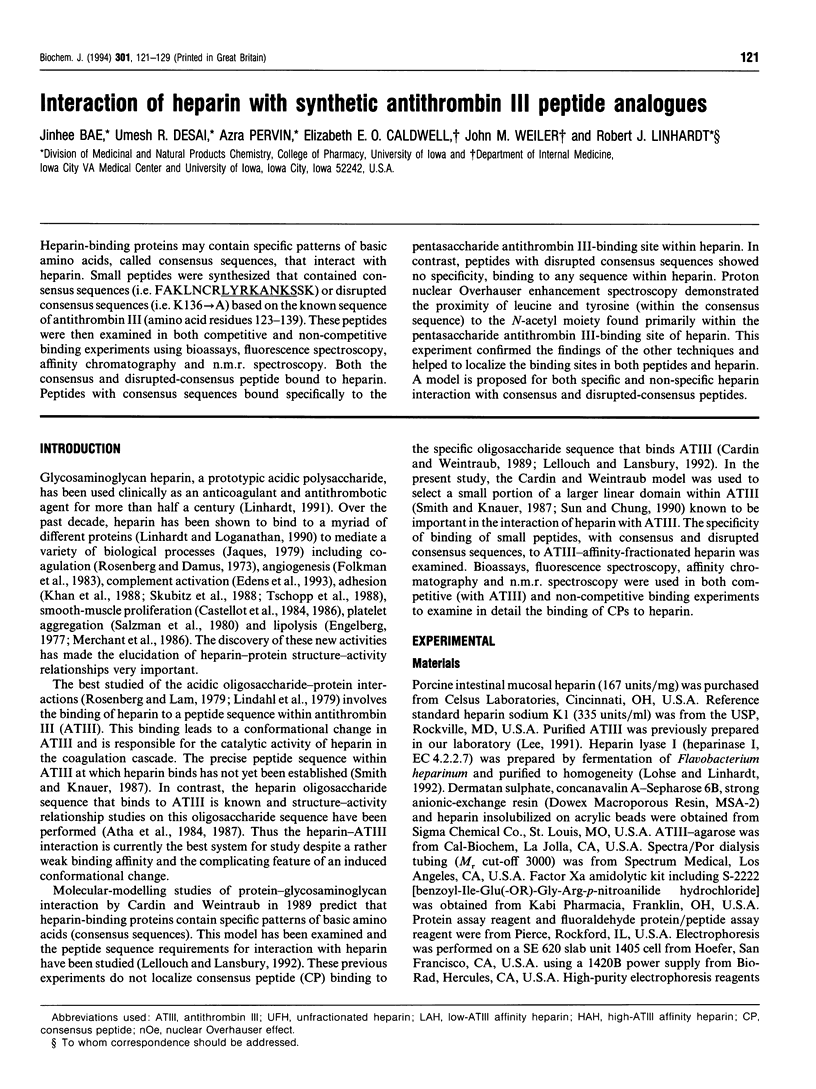
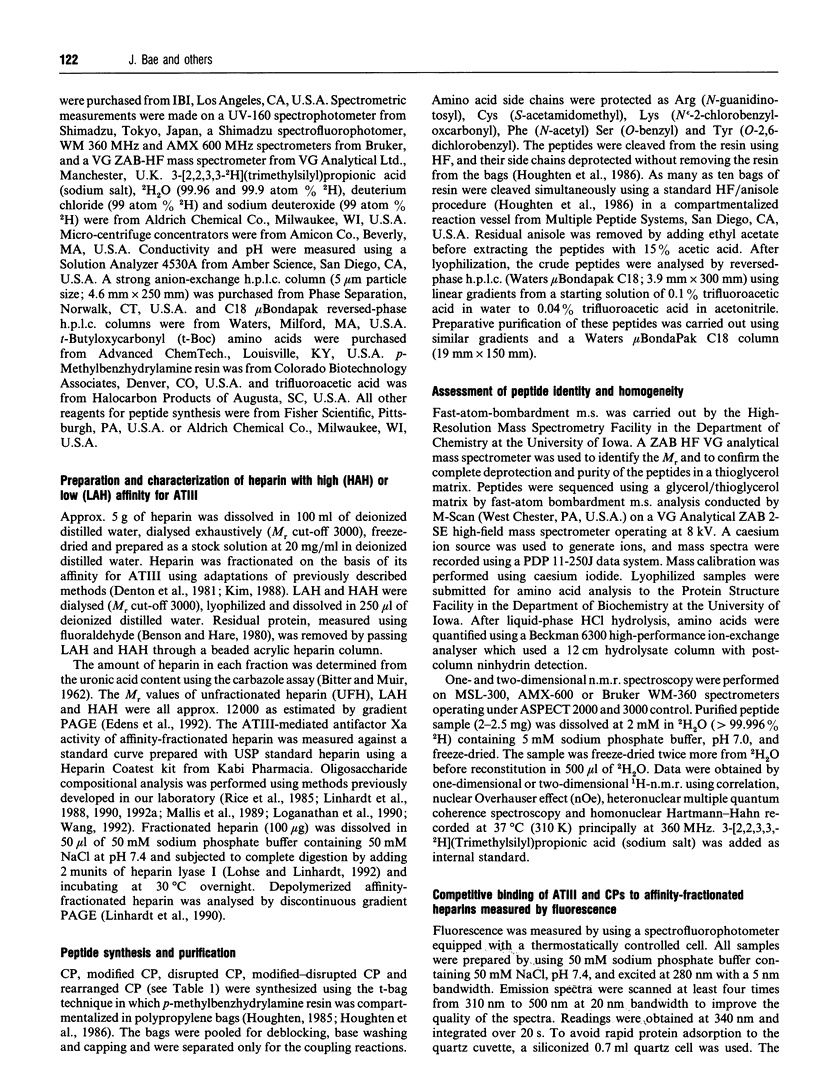
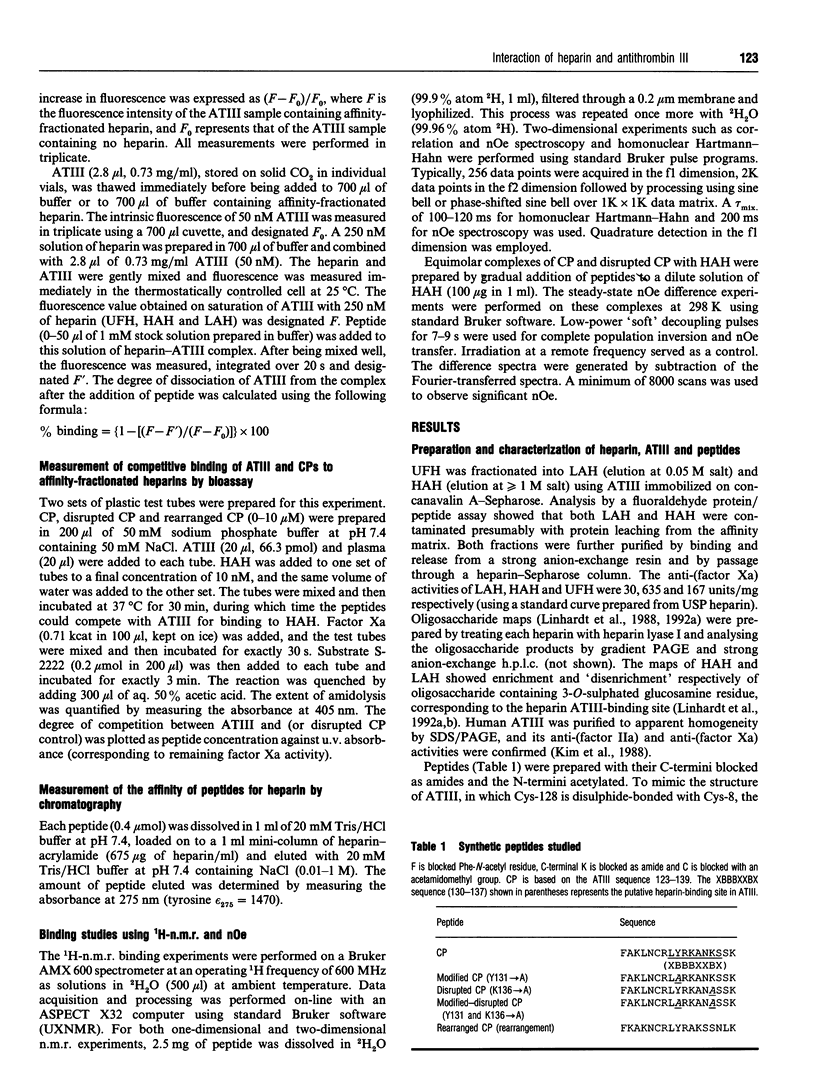
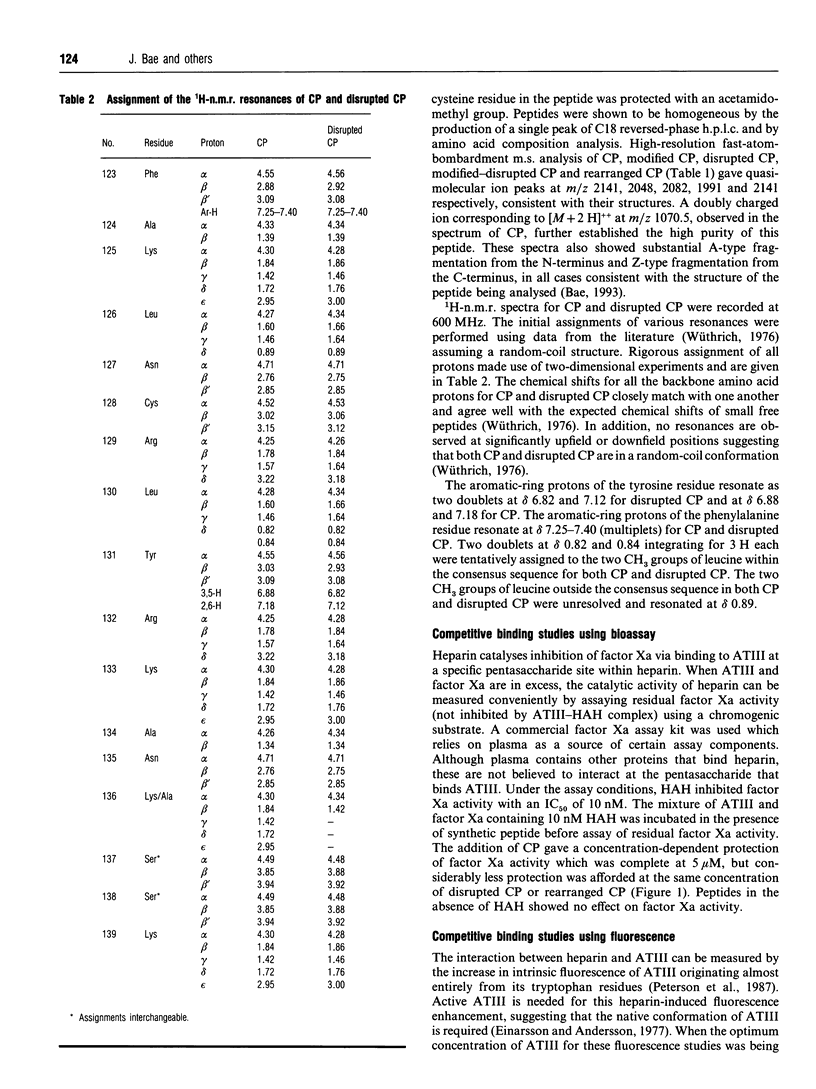
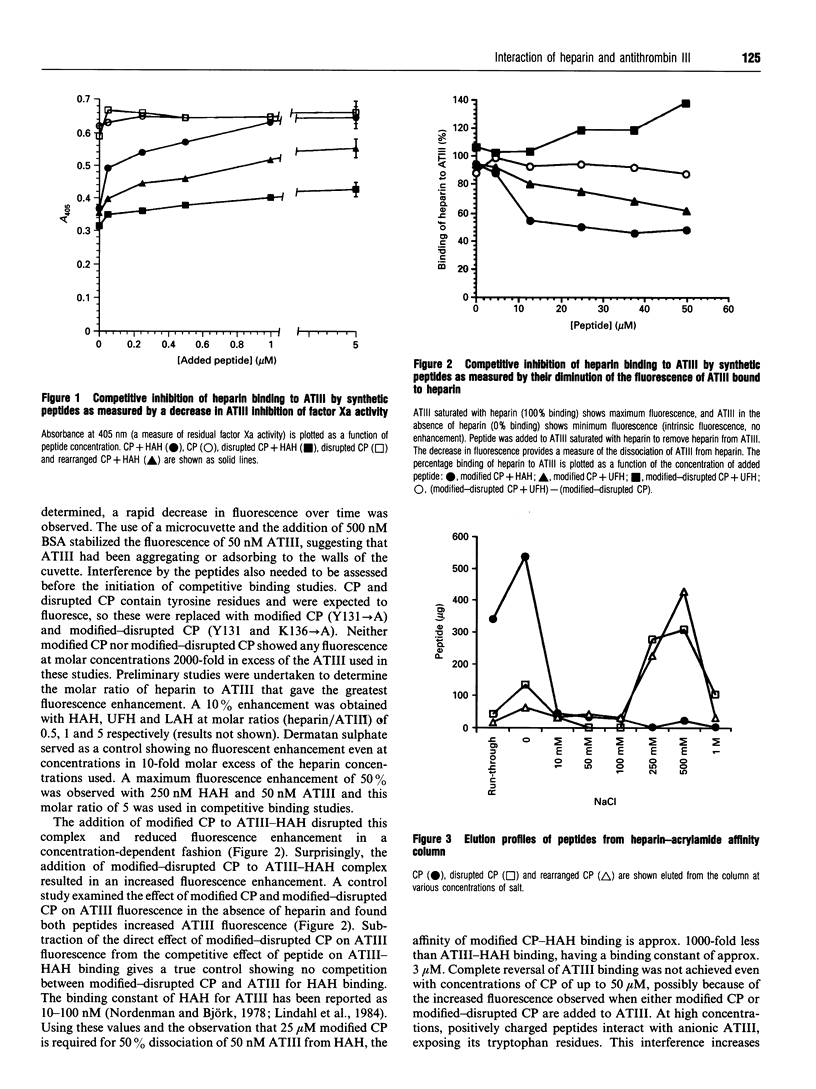
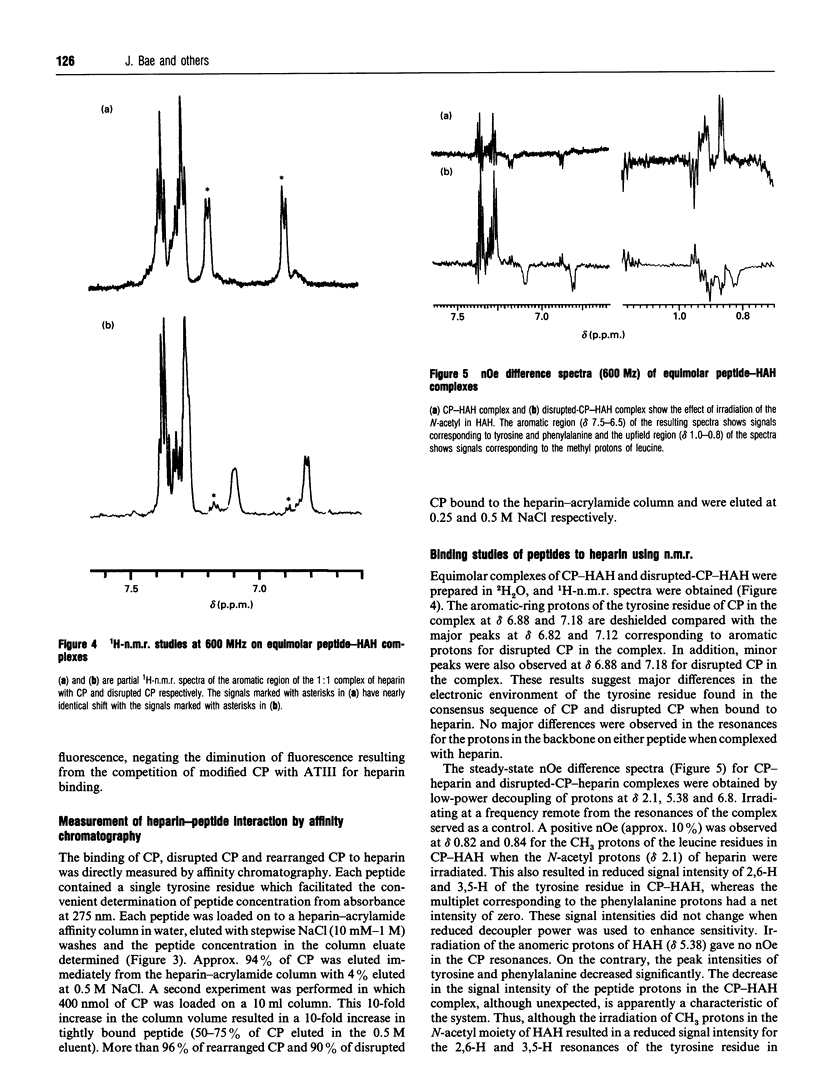
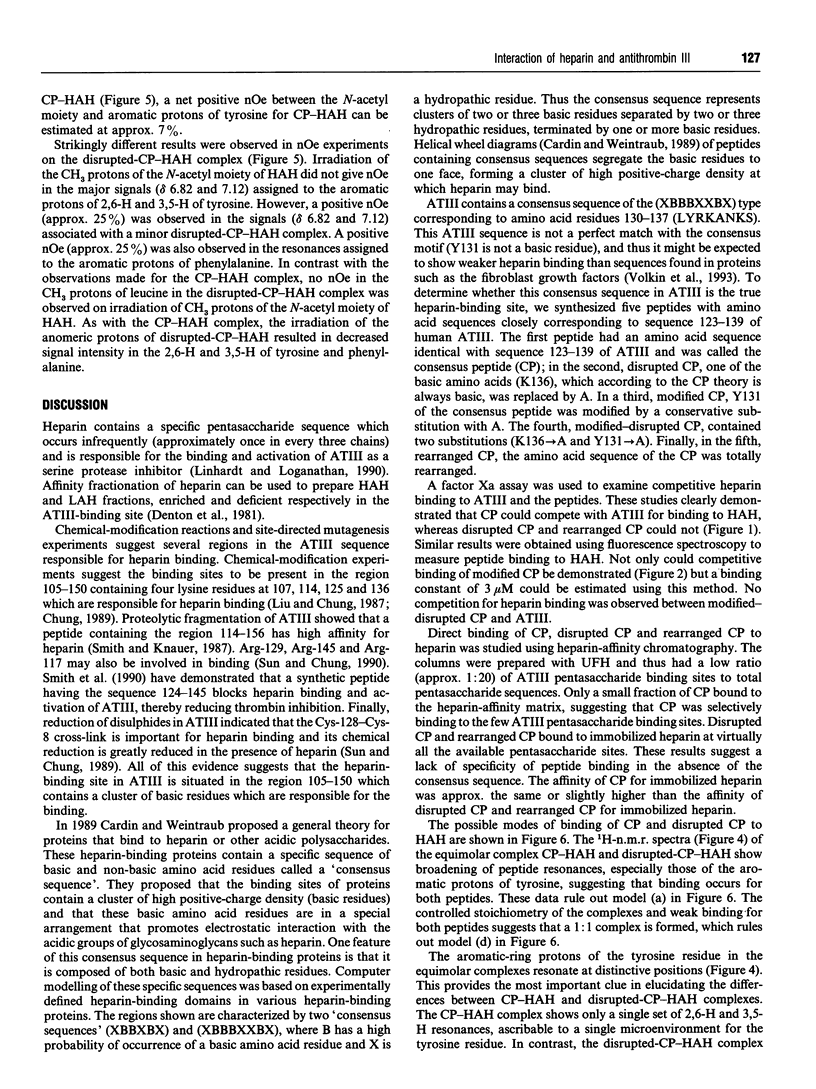
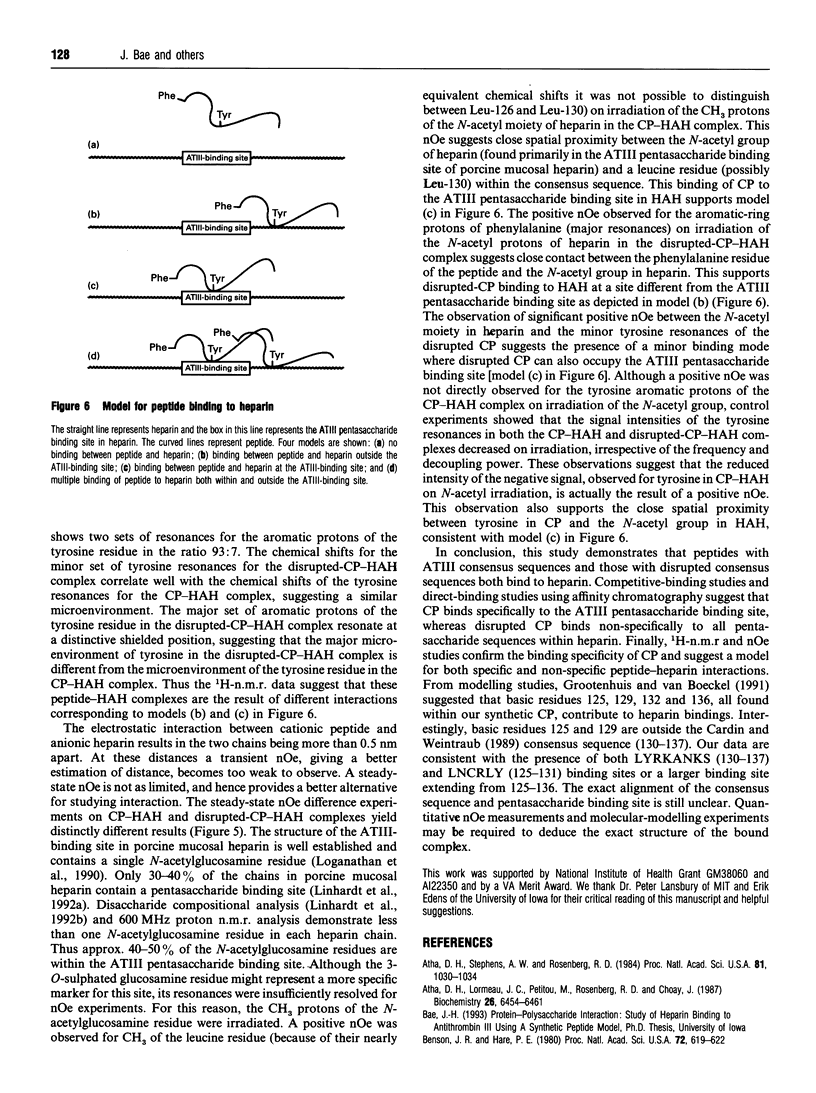
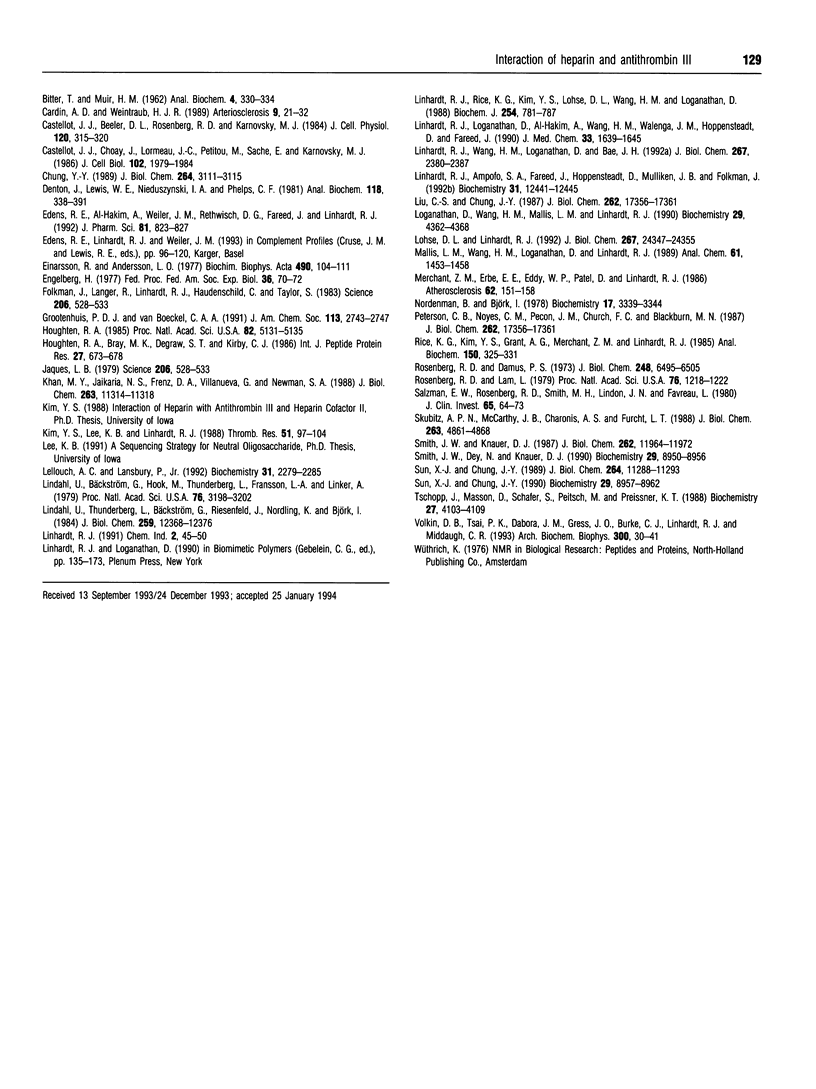
Selected References
These references are in PubMed. This may not be the complete list of references from this article.
- Atha D. H., Lormeau J. C., Petitou M., Rosenberg R. D., Choay J. Contribution of 3-O- and 6-O-sulfated glucosamine residues in the heparin-induced conformational change in antithrombin III. Biochemistry. 1987 Oct 6;26(20):6454–6461. doi: 10.1021/bi00394a024. [DOI] [PubMed] [Google Scholar]
- Atha D. H., Stephens A. W., Rosenberg R. D. Evaluation of critical groups required for the binding of heparin to antithrombin. Proc Natl Acad Sci U S A. 1984 Feb;81(4):1030–1034. doi: 10.1073/pnas.81.4.1030. [DOI] [PMC free article] [PubMed] [Google Scholar]
- BITTER T., MUIR H. M. A modified uronic acid carbazole reaction. Anal Biochem. 1962 Oct;4:330–334. doi: 10.1016/0003-2697(62)90095-7. [DOI] [PubMed] [Google Scholar]
- Benson J. R., Hare P. E. O-phthalaldehyde: fluorogenic detection of primary amines in the picomole range. Comparison with fluorescamine and ninhydrin. Proc Natl Acad Sci U S A. 1975 Feb;72(2):619–622. doi: 10.1073/pnas.72.2.619. [DOI] [PMC free article] [PubMed] [Google Scholar]
- Cardin A. D., Weintraub H. J. Molecular modeling of protein-glycosaminoglycan interactions. Arteriosclerosis. 1989 Jan-Feb;9(1):21–32. doi: 10.1161/01.atv.9.1.21. [DOI] [PubMed] [Google Scholar]
- Castellot J. J., Jr, Beeler D. L., Rosenberg R. D., Karnovsky M. J. Structural determinants of the capacity of heparin to inhibit the proliferation of vascular smooth muscle cells. J Cell Physiol. 1984 Sep;120(3):315–320. doi: 10.1002/jcp.1041200309. [DOI] [PubMed] [Google Scholar]
- Castellot J. J., Jr, Choay J., Lormeau J. C., Petitou M., Sache E., Karnovsky M. J. Structural determinants of the capacity of heparin to inhibit the proliferation of vascular smooth muscle cells. II. Evidence for a pentasaccharide sequence that contains a 3-O-sulfate group. J Cell Biol. 1986 May;102(5):1979–1984. doi: 10.1083/jcb.102.5.1979. [DOI] [PMC free article] [PubMed] [Google Scholar]
- Chang J. Y. Binding of heparin to human antithrombin III activates selective chemical modification at lysine 236. Lys-107, Lys-125, and Lys-136 are situated within the heparin-binding site of antithrombin III. J Biol Chem. 1989 Feb 25;264(6):3111–3115. [PubMed] [Google Scholar]
- Denton J., Lewis W. E., Nieduszynski I. A., Phelps C. F. Fractionation of heparin using antithrombin III reversibly bound to concanavalin A-sepharose. Anal Biochem. 1981 Dec;118(2):388–391. doi: 10.1016/0003-2697(81)90598-4. [DOI] [PubMed] [Google Scholar]
- Edens R. E., al-Hakim A., Weiler J. M., Rethwisch D. G., Fareed J., Linhardt R. J. Gradient polyacrylamide gel electrophoresis for determination of molecular weights of heparin preparations and low-molecular-weight heparin derivatives. J Pharm Sci. 1992 Aug;81(8):823–827. doi: 10.1002/jps.2600810821. [DOI] [PubMed] [Google Scholar]
- Einarsson R., Andersson L. O. Binding of heparin to human antithrombin III as studied by measurements of tryptophan fluorescence. Biochim Biophys Acta. 1977 Jan 25;490(1):104–111. doi: 10.1016/0005-2795(77)90110-6. [DOI] [PubMed] [Google Scholar]
- Engelberg H. Probable physiologic functions of heparin. Fed Proc. 1977 Jan;36(1):70–72. [PubMed] [Google Scholar]
- Houghten R. A., Bray M. K., Degraw S. T., Kirby C. J. Simplified procedure for carrying out simultaneous multiple hydrogen fluoride cleavages of protected peptide resins. Int J Pept Protein Res. 1986 Jun;27(6):673–678. doi: 10.1111/j.1399-3011.1986.tb01064.x. [DOI] [PubMed] [Google Scholar]
- Houghten R. A. General method for the rapid solid-phase synthesis of large numbers of peptides: specificity of antigen-antibody interaction at the level of individual amino acids. Proc Natl Acad Sci U S A. 1985 Aug;82(15):5131–5135. doi: 10.1073/pnas.82.15.5131. [DOI] [PMC free article] [PubMed] [Google Scholar]
- Jacques L. B. Heparin: an old drug with a new paradigm. Science. 1979 Nov 2;206(4418):528–533. doi: 10.1126/science.386509. [DOI] [PubMed] [Google Scholar]
- Khan M. Y., Jaikaria N. S., Frenz D. A., Villanueva G., Newman S. A. Structural changes in the NH2-terminal domain of fibronectin upon interaction with heparin. Relationship to matrix-driven translocation. J Biol Chem. 1988 Aug 15;263(23):11314–11318. [PubMed] [Google Scholar]
- Kim Y. S., Lee K. B., Linhardt R. J. Microheterogeneity of plasma glycoproteins heparin cofactor II and antithrombin III and their carbohydrate analysis. Thromb Res. 1988 Jul 1;51(1):97–104. doi: 10.1016/0049-3848(88)90286-1. [DOI] [PubMed] [Google Scholar]
- Lellouch A. C., Lansbury P. T., Jr A peptide model for the heparin binding site of antithrombin III. Biochemistry. 1992 Mar 3;31(8):2279–2285. doi: 10.1021/bi00123a010. [DOI] [PubMed] [Google Scholar]
- Lindahl U., Bäckström G., Hök M., Thunberg L., Fransson L. A., Linker A. Structure of the antithrombin-binding site in heparin. Proc Natl Acad Sci U S A. 1979 Jul;76(7):3198–3202. doi: 10.1073/pnas.76.7.3198. [DOI] [PMC free article] [PubMed] [Google Scholar]
- Lindahl U., Thunberg L., Bäckström G., Riesenfeld J., Nordling K., Björk I. Extension and structural variability of the antithrombin-binding sequence in heparin. J Biol Chem. 1984 Oct 25;259(20):12368–12376. [PubMed] [Google Scholar]
- Linhardt R. J., Ampofo S. A., Fareed J., Hoppensteadt D., Mulliken J. B., Folkman J. Isolation and characterization of human heparin. Biochemistry. 1992 Dec 15;31(49):12441–12445. doi: 10.1021/bi00164a020. [DOI] [PubMed] [Google Scholar]
- Linhardt R. J., Loganathan D., al-Hakim A., Wang H. M., Walenga J. M., Hoppensteadt D., Fareed J. Oligosaccharide mapping of low molecular weight heparins: structure and activity differences. J Med Chem. 1990 Jun;33(6):1639–1645. doi: 10.1021/jm00168a017. [DOI] [PubMed] [Google Scholar]
- Linhardt R. J., Rice K. G., Kim Y. S., Lohse D. L., Wang H. M., Loganathan D. Mapping and quantification of the major oligosaccharide components of heparin. Biochem J. 1988 Sep 15;254(3):781–787. doi: 10.1042/bj2540781. [DOI] [PMC free article] [PubMed] [Google Scholar]
- Linhardt R. J., Wang H. M., Loganathan D., Bae J. H. Search for the heparin antithrombin III-binding site precursor. J Biol Chem. 1992 Feb 5;267(4):2380–2387. [PubMed] [Google Scholar]
- Liu C. S., Chang J. Y. The heparin binding site of human antithrombin III. Selective chemical modification at Lys114, Lys125, and Lys287 impairs its heparin cofactor activity. J Biol Chem. 1987 Dec 25;262(36):17356–17361. [PubMed] [Google Scholar]
- Liu C. S., Chang J. Y. The heparin binding site of human antithrombin III. Selective chemical modification at Lys114, Lys125, and Lys287 impairs its heparin cofactor activity. J Biol Chem. 1987 Dec 25;262(36):17356–17361. [PubMed] [Google Scholar]
- Loganathan D., Wang H. M., Mallis L. M., Linhardt R. J. Structural variation in the antithrombin III binding site region and its occurrence in heparin from different sources. Biochemistry. 1990 May 8;29(18):4362–4368. doi: 10.1021/bi00470a015. [DOI] [PubMed] [Google Scholar]
- Lohse D. L., Linhardt R. J. Purification and characterization of heparin lyases from Flavobacterium heparinum. J Biol Chem. 1992 Dec 5;267(34):24347–24355. [PubMed] [Google Scholar]
- Mallis L. M., Wang H. M., Loganathan D., Linhardt R. J. Sequence analysis of highly sulfated, heparin-derived oligosaccharides using fast atom bombardment mass spectrometry. Anal Chem. 1989 Jul 1;61(13):1453–1458. doi: 10.1021/ac00188a030. [DOI] [PubMed] [Google Scholar]
- Merchant Z. M., Erbe E. E., Eddy W. P., Patel D., Linhardt R. J. Effect of very low molecular weight heparin-derived oligosaccharides on lipoprotein lipase release in rabbits. Atherosclerosis. 1986 Nov;62(2):151–158. doi: 10.1016/0021-9150(86)90061-4. [DOI] [PubMed] [Google Scholar]
- Nordenman B., Björk I. Binding of low-affinity and high-affinity heparin to antithrombin. Ultraviolet difference spectroscopy and circular dichroism studies. Biochemistry. 1978 Aug 8;17(16):3339–3344. doi: 10.1021/bi00609a026. [DOI] [PubMed] [Google Scholar]
- Rice K. G., Kim Y. S., Grant A. C., Merchant Z. M., Linhardt R. J. High-performance liquid chromatographic separation of heparin-derived oligosaccharides. Anal Biochem. 1985 Nov 1;150(2):325–331. doi: 10.1016/0003-2697(85)90518-4. [DOI] [PubMed] [Google Scholar]
- Rosenberg R. D., Damus P. S. The purification and mechanism of action of human antithrombin-heparin cofactor. J Biol Chem. 1973 Sep 25;248(18):6490–6505. [PubMed] [Google Scholar]
- Rosenberg R. D., Lam L. Correlation between structure and function of heparin. Proc Natl Acad Sci U S A. 1979 Mar;76(3):1218–1222. doi: 10.1073/pnas.76.3.1218. [DOI] [PMC free article] [PubMed] [Google Scholar]
- Salzman E. W., Rosenberg R. D., Smith M. H., Lindon J. N., Favreau L. Effect of heparin and heparin fractions on platelet aggregation. J Clin Invest. 1980 Jan;65(1):64–73. doi: 10.1172/JCI109661. [DOI] [PMC free article] [PubMed] [Google Scholar]
- Skubitz A. P., McCarthy J. B., Charonis A. S., Furcht L. T. Localization of three distinct heparin-binding domains of laminin by monoclonal antibodies. J Biol Chem. 1988 Apr 5;263(10):4861–4868. [PubMed] [Google Scholar]
- Smith J. W., Dey N., Knauer D. J. Heparin binding domain of antithrombin III: characterization using a synthetic peptide directed polyclonal antibody. Biochemistry. 1990 Sep 25;29(38):8950–8957. doi: 10.1021/bi00490a010. [DOI] [PubMed] [Google Scholar]
- Smith J. W., Knauer D. J. A heparin binding site in antithrombin III. Identification, purification, and amino acid sequence. J Biol Chem. 1987 Sep 5;262(25):11964–11972. [PubMed] [Google Scholar]
- Sun X. J., Chang J. Y. Evidence that arginine-129 and arginine-145 are located within the heparin binding site of human antithrombin III. Biochemistry. 1990 Sep 25;29(38):8957–8962. doi: 10.1021/bi00490a011. [DOI] [PubMed] [Google Scholar]
- Sun X. J., Chang J. Y. Heparin binding domain of human antithrombin III inferred from the sequential reduction of its three disulfide linkages. An efficient method for structural analysis of partially reduced proteins. J Biol Chem. 1989 Jul 5;264(19):11288–11293. [PubMed] [Google Scholar]
- Tschopp J., Masson D., Schäfer S., Peitsch M., Preissner K. T. The heparin binding domain of S-protein/vitronectin binds to complement components C7, C8, and C9 and perforin from cytolytic T-cells and inhibits their lytic activities. Biochemistry. 1988 May 31;27(11):4103–4109. doi: 10.1021/bi00411a029. [DOI] [PubMed] [Google Scholar]
- Volkin D. B., Tsai P. K., Dabora J. M., Gress J. O., Burke C. J., Linhardt R. J., Middaugh C. R. Physical stabilization of acidic fibroblast growth factor by polyanions. Arch Biochem Biophys. 1993 Jan;300(1):30–41. doi: 10.1006/abbi.1993.1005. [DOI] [PubMed] [Google Scholar]


